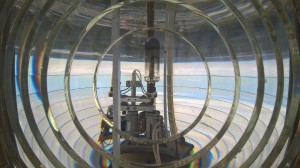This next installment in our series on lighthouse technology focuses on the illuminants lighthouses have used, especially those used at the St. Augustine Lighthouse in it history.
Click the link below to read previous post in the series:
Lighthouse Illumination

This US Lighthouse Establishment 100 gallon oil butt sits in the oil room of the St. Augustine Lighthouse.
Historically, lighthouses have served as a reflection of a culture’s technological sophistication. Because of their navigational importance, lighthouses drove and benefited from advancements in lighting technology. From the first fires set atop high hills to today’s automated beacons, lighthouses have changed and adapted to keep their lights shining as brightly and efficiently as possible.
Early lighthouses burned wood, coal, or candles to provide illumination. By the early 1800s, most U.S. lighthouses used whale oil as fuel in their oil lanterns. Whale oil is rendered from whale blubber and was a common fuel for lanterns of all sizes in the early 19th century, lighthouses included. The New England whaling industry supplied all the whale oil the country’s lighthouses needed through the mid-19th century. The availability and excellent qualities of whale oil made it an ideal fuel for lighthouses that had to stay lit through the night.
By the middle of the 1800s, the whale industry began to suffer from its own success and efficiency. Their efforts had severely decreased the whale population and the corresponding decrease in supply drove costs high enough that the Lighthouse Board began looking for alternative fuels to illuminate the nation’s lighthouses.
The Board considered several options for their new fuel, including kerosene (mineral oil), colza oil, and lard oil. In their 1874 report to the U.S. Senate, the Lighthouse Board (through the Department of the Treasury) reported that they had “…made extensive researches with regard to lighting materials…and have given the preference to lard as an illuminating material on account of its excellent qualities, particularly in lights of the first order.” The Board also considered electricity and natural gas but decided against those “…on account of the complexity and cost of the apparatus” needed to use them.
The old St. Augustine Lighthouse likely used whale oil as its primary fuel. The current St. Augustine Lighthouse, completed in 1874, probably began with lard oil though may have made use of whale oil before stores of that fuel depleted. Despite their initial enthusiasm, the Lighthouse Board’s decision to use lard oil did not last long. By 1877, they reported a preference for the less expensive and more combustible kerosene though it took several years to convert all U.S. lighthouses to the new fuel. The St. Augustine Lighthouse continued using lard oil until December 17, 1885 when the Lighthouse Tender Fern arrived with kerosene.
The fuel also known as mineral oil remained the standard for the nation’s lighthouses until the introduction of available electricity. Several lighthouses converted to an electric light source before 1900; yet the St. Augustine Lighthouse would have to wait until 1936.

This view through the St. Augustine Lighthouse’s First Order Fresnel lens shows the current electric bulb.
On March 1, 1936, the St. Augustine Record reported that principle radio electrician T.A. McKee, along with machinist R.A. Adams and Head Keeper C.D. Daniels had completed “the electrification of the tower light” with an “electric bulb of 1,000 watts,” which is the same intensity we use today. The electrification of the lighthouse made the Second Assistant Keeper unnecessary and led to the elimination of the position.
Although many may consider the lighthouse’s oil lantern more “authentic” than the electric bulb, it is interesting to note that the lighthouse has been electrified longer than it was illuminated by oil. The St. Augustine Lighthouse used various types of oil for 62 years, from 1874 to 1936. March 1, 2016 will mark the 80th anniversary of the conversion to electricity.
Our electric light is still shining, serving as a navigational aid for mariners in the area. Come visit the lighthouse for a Dark of the Moon tour and see the light up close!
Paul Zielinski is Director of Interpretation for the St. Augustine Lighthouse & Maritime Museum. He received his master’s degree in Public History from the University of West Florida and joined the lighthouse family in 2011.

